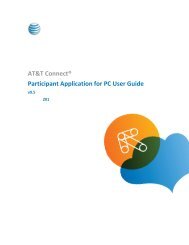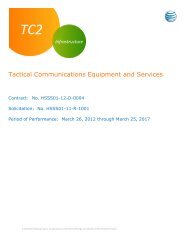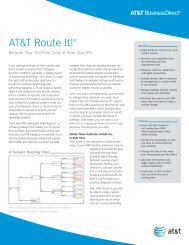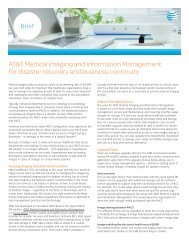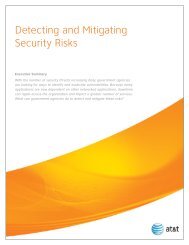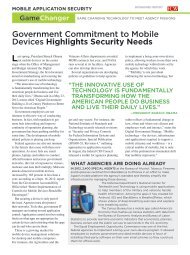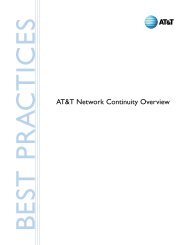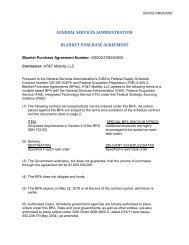Thinking About Enabling Convergence - AT&T
Thinking About Enabling Convergence - AT&T
Thinking About Enabling Convergence - AT&T
You also want an ePaper? Increase the reach of your titles
YUMPU automatically turns print PDFs into web optimized ePapers that Google loves.
<strong>Thinking</strong> <strong>About</strong><strong>Enabling</strong> <strong>Convergence</strong>A Four Point FrameworkAT&T’s Four Points of <strong>Convergence</strong>The convergence of networking technologies today is creating powerful new methods to help organizations strengthen theirperformance. The keys to convergence success are to understand what convergence can achieve for your organization,determine which convergence areas will provide the greatest benefit, and plan and implement the steps required to makeconvergence a success.What is <strong>Convergence</strong>?<strong>Convergence</strong> was once thought of simply as the ability to senddigitized voice and data over a shared network. Today the pictureis more comprehensive. <strong>Convergence</strong> can benefit virtually everyorganization activity. As you extend convergence across yourorganization, AT&T believes there is a clear Four Point Frameworkfor <strong>Convergence</strong>, which your organization can employ simultaneouslyor in order of maximum benefit:• Integrate your on-net options for mobile and fixed access• Enable your networks with multi-protocol label switching (MPLS)• Optimize your applications infrastructure• Take advantage of VoIP and other Services over Internet ProtocolThe Promise of <strong>Convergence</strong><strong>Convergence</strong> has the power to strengthen organizational performanceand efficiency in several key dimensions.First, a converged networking infrastructure can help enhance theoperational efficiencies and productivity of your organization.Organization applications, from straightforward Voice over InternetProtocol (VoIP) to sophisticated customer relationship management(CRM) and organization resource planning (ERP) systems, perform morereliably and deliver greater value after the divisions that separatelegacy networks have been erased through convergence.A second benefit is enhanced organizational agility. By integratingmultiple communication channels and increasing the richness ofcommunications, converged systems can move information to thepeople who need it – whether they are decision makers, distributors,sales people, service representatives, customers or suppliers – faster.Your organization can reach and implement decisions quicker, shortentime-to-market cycles and enhance workflow responsiveness to realorganization needs.Converged systems also increase management’s ability to controlactivities across the organization, identify changing circumstancesand adjust network performance in response to those changes.This means the whole organization can adapt more effectively tochanges in the operating environment.A main concern about convergence has been security. In a 2005global survey, more than two thirds of respondents rated security asthe single most critical aspect of network performance, and almostas many (64 percent) cited security issues as a barrier to convergence.Without careful planning, the integration of fixed and wirelessnetworks could make it even more difficult to protect mobile data.The answer is to integrate security plans and measures throughoutthe convergence process. Security for converged networks andservices must be built in, not bolted on as an afterthought.Closely related to security is the issue of organization continuity – theability to remain productive in spite of disruptive events. Convergedcommunication systems can be set up to provide diversecommunication channels and access options that can enableemployees to remain mobile, stay in touch and work productivelyfrom almost anywhere.More than just delivering lower capital and operational expenditures,network convergence should be focused on creating the nextgeneration of services that will enable your customers or partnersto increase value.The promise is proving persuasive for organization leaders. In a 2005global survey, 60 percent of executives said they will have deployedconverged networks across most or all of their organizations by 2008.Almost half (45 percent) said they consider convergence important orcritical to achieving their strategic IT and organization objectives.
<strong>Thinking</strong> <strong>About</strong> - <strong>Enabling</strong> <strong>Convergence</strong>: A Four Framework ____________________________________________________________________________________ 3MPLS enables service providers to offer simpler, higher caliber servicesthat are easier to manage. Now it is organization needs, not thelimitations of networks, which set the IT agenda. Network-based,end-to-end Class of Service traffic management ensures high qualityfor such applications as VoIP and IP television. Using MPLS networksas the base for Virtual Private Networks ensures communicationprivacy and security.Enterprises will increasingly turn to MPLS as carriersmerge and provide larger, more stable IP/MPLSnetworks as foundations for valuable services suchas network-based VoIP. 3Robert Whitely, Forrester Research, Inc.According to Robert Whitely of Forrester Research, “Enterprises willincreasingly turn to MPLS as carriers merge and provide larger, morestable IP/MPLS networks as foundations for valuable services such asnetwork-based VoIP. ”Future MPLS networks will use “traffic shaping” technologies todynamically adjust capacity and prioritize specific applications, asdemands on the network change. Network-based applicationintelligence will make the network itself “aware” of the kinds ofapplications moving across the network. The network will thenautomatically adjust its behavior to optimize application performance.Planning for your MPLS network begins with a detailed analysis ofwhich applications will use the network, how much bandwidth theywill require and the usage patterns and organization locations thenetwork must accommodate.Consider too your need for redundancy and organization continuityand the kinds of edge devices and access technologies you will use.Multinational organizations must also consider the higher cost ofinternational bandwidth and how to manage the sometimesinconsistent standards and protocols in use by local service providers.Optimize Your Application InfrastructureOrganization applications such as data storage and retrieval,organization resource planning (ERP), Voice over Internet Protocol(VoIP), messaging, Internet protocol television (IPTV), supply chainmanagement (SCM), bridging-based collaboration services such asvideo and audio conferencing, and others run and depend on a highperformance infrastructure.Increasingly, organizations are replacing legacy infrastructures,characterized by separate network elements, systems and applications,with a converged, unified and dynamic application infrastructure.The converged infrastructure supports on-demand and automatedorganization applications with full interoperability, stability andcentrally managed SLAs, including dynamic cross-applicationnetwork policies.A dynamic network unites these diverse systems, increasing applicationreliability and performance, and simplifying the job of makingapplications work together. And new capabilities are emerging.Networks will soon deliver such features as application-sensitiveperformance levels, location-awareness for mobile applications, andpersonalized applications customized for the needs of each end-user.Intelligence built into the network will respond automatically tochanging conditions. For example, when a high-bandwidth, highqualityapplication like IPTV comes online, the network willautomatically allocate the needed bandwidth and apply Class ofService controls to ensure quality. When broadcast time is over,the network will return to organization as usual.To get started in optimizing the applications infrastructure in yourorganization, think through these questions:• What applications are essential to your operations today, and whatnew applications will you be using in the future?• Who uses these applications and how do they access them?How can you deliver consistent levels of performance to users inall your locations?• To what extent must your various applications interact andexchange information with each other?• Do you have the resources to accomplish the job? And even if youhave the resources in house, is this how you want to use them? Inessence, this is a build versus buy decision. Service providers offerhosting and outsourcing options that range from simple floor spacein a secure data center, to full management of your applicationsinfrastructure, to management of the applications themselves.Take Advantage of Services Over Internet ProtocolInstead of using separate voice, video, conferencing and messagingservices, organizations can gain efficiencies and new capabilities byintegrating these services into a seamless communications environment.Internet protocol (IP) is the unifying technology that makes possible anextraordinary level of convergence and interoperability amongcommunications systems, applications and devices.VoIP, the best known IP-based service today, is revolutionizing thetelecommunications market and challenging traditional circuitswitchedservices that travel over the public network. But other IPservices are emerging. For example, instead of purchasing andmaintaining a PBX on site, organizations can buy IP-based telephonyservices, which are sophisticated call processing capabilities sold asan end-to-end managed service. IP television, conferencing andmessaging services are similarly coming to market.Future services over IP will include click-to-call capability in anynetwork device. Presence-awareness will help callers know whetherthe person they’re trying to reach is available, and over which device.Thus callers can avoid communication “side tracks” like voice mail,and increase their percentage of “direct hits” that reach the personthey are calling.
<strong>Thinking</strong> <strong>About</strong> - <strong>Enabling</strong> <strong>Convergence</strong>: A Four Framework ____________________________________________________________________________________ 4<strong>Convergence</strong> and the DHL NetworkNetwork convergence isn’t an option for DHL Express, theovernight delivery arm of Deutsche Poste. It’s a necessity.Operating in 220 countries, the DHL global IP network isrun from three primary data centers in Arizona, Malaysiaand the Czech Republic.Every eight hours, command and control for all of thecompany’s global IP-based voice, data and video servicespasses from one data center to another. Each center hasthe same tools for operating the network in terms ofmanaging trouble tickets, as well as tracking the flow ofmillions of packages every day through numerousendpoints (around 300,000) and a highly mobile workforce.Tracking and tracing packages through the IP network ismore than a matter of simply ensuring that a customer canlook up the status of their order on the web. For theexpress delivery organization, being able to exchangeinformation and communications while packages are intransit is crucial for meeting delivery cut-off dates. Forexample, DHL uses information from its network to clearover 90% of its European packages with U.S. authoritieswhile the cargo plane is still in the air.Even so, digital information can only go so far. Authoritiescan ask the company to produce a physical package forinspection at any time. Given the fact that a transatlanticcargo jet typically carries about 90,000 lbs of packageswith an average weight of 2-4 lbs, being able to track andfind a particular package quickly is no trivial matter.“If you don’t have the capability to know where that onepackage is, it can take hours and we only have about 2-3hours to get material off a plane, sort it and re-route itto its final destination,” says Mr. Bandrowczak. “Soinformation is extremely critical.”To prepare for the transition to Services over IP, you should consider:• Creating an inventory to assess call flows and feature functionalityrequirements• Consider the level of interoperability that exists across your existingcommunications infrastructure – and how much you may need toexpand interoperability to deliver services over IP• Developing a multi-year IP communications evolution plan to alignyour technology capabilities with your organization objectives anddeliver consistent global performance• How much of the job you wish to take on within your organization,and how much you can purchase as a managed service from anoutside provider<strong>Convergence</strong> in Your OrganizationThe enhanced integration and interoperation made possible byconvergence are very much worth the effort. <strong>Convergence</strong> todayis a fundamental strategic concept for IT leaders. As you plan yourorganization’s convergence strategy, consider these four convergencefocal points. These are not sequential steps. Rather they are compasspoints of opportunity. We hope that they will help you direct yourorganization toward the opportunities of the future.This is one in a series of five papers AT&T has developed to helporganizations with their convergence decisions – to provide insightinto the “how to” of convergence and examine the practical issuesyour organization must overcome as you integrate convergedcommunications into your organization operations.<strong>About</strong> AT&T Government SolutionsEvery day, thousands of experienced AT&T Government Solutionsprofessionals go beyond expectation, deploying visionary solutionsthat serve our citizens, defend our nation and prepare for the future.We serve the federal government as a trusted provider, backed by aproven performance record in delivering mission-enabling solutions.Fusing our core networking capabilities and our professional servicesexpertise along with innovation from AT&T Labs, we are driven tomeet the toughest agency demands today, while establishing a pathto emerging technologies.Underpinning every solution we build are the global resources andassets of one of the largest providers of communications servicesin the world. Our dynamic service management tools, advancedtechnology and an experienced staff modernize operations andenhance our customers’ experience, enabling agencies to focuson their mission — not their IT challenges.For more information contact:AT&T Government Solutions1900 Gallows RoadVienna, VA 22182www.att.com/govReferences1. “Competing through <strong>Convergence</strong>,” survey by Economist IntelligenceUnit and AT&T, p. 5. ©2005 AT&T.2. Ibid., p. 1.3. 2005 Enterprise VPN Adoption Trends, Oct 11, 2005 ForresterResearchTo learn more about our full array of products and services, contact yourAT&T Client Business Manager at: 1.800.862.0926 or www.att.com/gov.© 2006 AT&T Knowledge Ventures. All rights reserved. 05/05/06 TS-0199



